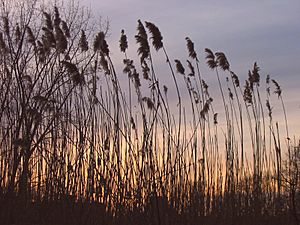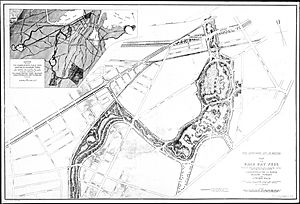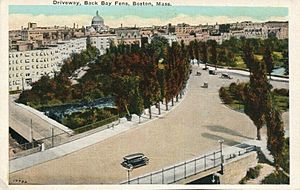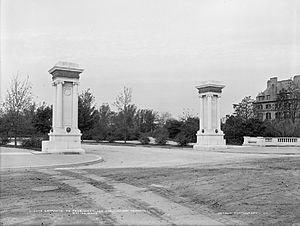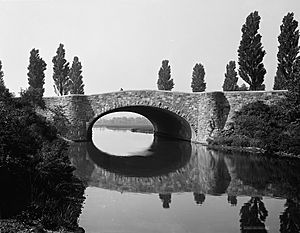Back Bay Fens facts for kids
Quick facts for kids Back Bay Fens |
|
|---|---|

The Back Bay Fens viewed from the Boylston Street bridge
|
|
| Location | Fenway–Kenmore, Boston |
| Created | 1879 |
| Designer | Frederick Law Olmsted |
|
Olmstead Park System
|
|
| NRHP reference No. | 71000086 |
The Back Bay Fens, often called "'the Fens", is a cool park and natural area in Boston, Massachusetts. It was created in 1879. A famous landscape designer named Frederick Law Olmsted planned it. He wanted it to be a part of Boston's "Emerald Necklace" park system. The Fens even gave its name to the nearby Fenway-Kenmore neighborhood!
Contents
Discovering the Fens: A Park's Journey
The Fens is a big, beautiful park that is part of Boston's famous Emerald Necklace. It used to be a salty marshland, a wet area connected to the ocean tides. Over time, it was surrounded by dry land and changed into a park with fresh water. People sometimes call it the Fens or the Fenway.
From Swamp to City Park
When Boston was first settled in the 1600s, the area where the Fens is now was a muddy, tidal flat. This meant it was a low, flat area that filled with water from the Charles River when the tide came in. As Boston grew, the area became very smelly because of sewage.
To fix this problem and create more land for Boston, people started a huge project in 1820. They began filling in the bay with dirt and rocks. This "land reclamation" project continued for many years. By 1882, the filling of the Back Bay area was finished. The Fens area was completely filled by 1900. These projects actually doubled the size of the original Boston peninsula!
Frederick Law Olmsted, the park's designer, had a big challenge. He wanted to make the marshland healthy again and a fun place for people to visit. He used his amazing landscaping skills and smart engineering ideas. He turned a smelly swamp into a beautiful area with a winding creek and wooded banks.
Originally, Olmsted designed the Fens so that ocean tides would flush it twice a day. But in 1910, a dam was built on the Charles River. This stopped the ocean tides from reaching the Fens. After that, the Fens became a freshwater area, collecting rainwater from the Charles River Basin.
Later, another landscape architect, Arthur Shurcliff, added new parts to the park. He created the Kelleher Rose Garden and added an athletic field.
The Fens' Special Gardens
In 1941, during World War II, people in the Fens started a "victory garden". These gardens helped people grow their own food during the war. The Fens' Victory Garden is the only one from that time that is still used today! It's a cherished community garden where people grow flowers and vegetables.
In 1983, the Back Bay Fens was named a Boston Landmark. This means it's a very important historical and natural place. Today, the Emerald Necklace Conservancy has its main office in the park. They also run a visitor center that is open all year.
Exploring the Fens: Cool Features
The Back Bay Fens has many interesting parts to explore.
Park Entrances
The Fens was designed with several entrances. These entrances often had straight roads and neat lawns, which looked different from the wilder parts of the park.
The Beacon Entrance was once the main way into the park. It connected to Commonwealth Avenue. Over the years, this entrance changed a lot with new roads and bridges. Today, part of it is called Charlesgate Park.
The Boylston Entrance is near Boylston Street. A statue of John Boyle O'Reilly was placed here in 1894.
The Westland Entrance is on the east side of the Fens. It has beautiful lawns. The Westland Gate marks this entrance. It has two marble monuments with lion's-head fountains. These were built around 1905 and became the new main entrance to the Fens.
Bridges of the Fens
Several bridges cross the Muddy River within the Fens. These bridges help people and cars move through the park.
The Boylston Street bridge is one of the most important. It was designed by John C. Olmsted (Frederick Law Olmsted's adopted son) and architect Henry Hobson Richardson. It's made of stone and has unique tower-like features. It opened in 1884.
The Agassiz Road bridge connects different parts of the Fens. It has five small brick arches and uses stones from Franklin Park. This bridge was finished in 1888.
The Fen Bridge is at the west end of the Fens. It's a stone arch bridge that opened in 1892.
There are also two footbridges near the Museum of Fine Arts. These were rebuilt in 1979 to help people walk across the river.
Historic Buildings
The Fens has some interesting old buildings.
The Agassiz Road Duck House was built in 1897. It was once a public restroom. After a fire in 1986, its roof was rebuilt. It's the only building along Agassiz Road.
The Stony Brook Gatehouse was designed by Henry Hobson Richardson. It has a slate roof and walls made of smooth stones. This building used to control water flow. In 2010, it became the main office and visitor center for the Emerald Necklace Conservancy.
The Fire Alarm Office, built in 1925, is a grand limestone building. It has fancy bronze doors and a message about fighting fires carved into its front.
Monuments and Memorials
The Fens is home to many statues and memorials that honor important people and events.
A monument was put up in 1973 for baseball player Roberto Clemente. It's a stone marker with a bronze picture of Clemente. It says his three loves were "Puerto Rico, baseball, and children." The baseball field next to it is also named after him.
The Katharine Lee Bates monument honors the writer of "America the Beautiful". It's a granite tablet with a bronze plaque that includes the song's lyrics.
Near the Westland Gate is the John Boyle O'Reilly Memorial. This statue, made in 1894, remembers the Irish poet. It shows a bust of O'Reilly and a statue of a woman weaving a wreath.
A memorial for radio operators who died on merchant ships during World War II used to be here. It showed a sinking ship. It was moved to Peddocks Island in the 1990s.
The Temple Bell is a bronze bell from Japan, cast in 1675. It was given to Boston in 1953 as a symbol of peace after World War II.
John Endecott Monument
This large monument honors John Endecott, an early colonial leader. It features a white granite statue of Endecott in old-fashioned clothes. The monument also has a quote from 1654.
Veterans Memorial Park
This park has three memorials honoring soldiers. It was created in 1948.
The World War II memorial is the largest. It has a granite monument with names on bronze tablets and a large bronze angel statue. It also honors Sergeant Charles Andrew MacGillivary, a World War II hero.
The Korean War Memorial is smaller. It has a stone plaza with a map of Korea and columns with names from the war (1950–1953).
The Vietnam War Memorial is similar. It has a stone plaza with a map of Vietnam and columns with names from that war (1962–1975).
Beautiful Gardens
The Fens has two main garden areas.
The Victory Gardens are now named after Richard D. Parker, one of the first organizers. These gardens are very special because they are one of only two remaining World War II victory gardens in the U.S. They were started in 1942. Today, people in the community use these plots to grow vegetables and flowers.
The James P. Kelleher Rose Garden is a beautiful circular rose garden with a fountain. It was added in 1930. In 1975, it was named after James P. Kelleher, who was in charge of horticulture for Boston parks. The garden was fully restored in 2008 and again in 2014.
Fun Athletic Fields
The Fens also has places for sports and play.
An athletic track and field were built in 1923. It was later named the Joseph Lee Playground. Two baseball diamonds were added. One is dedicated to Roberto Clemente, and the other to local residents Brian and David Cobe. Two basketball courts were also added and named after Jim Bradley. In 2010, the field was updated for college-level sports.


